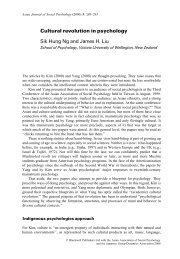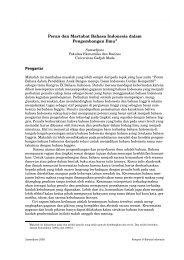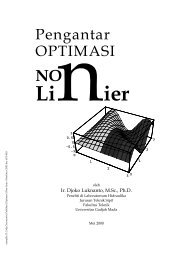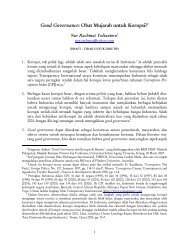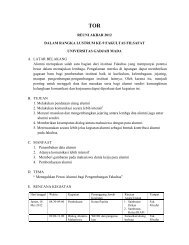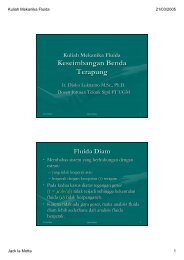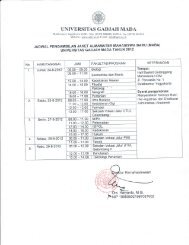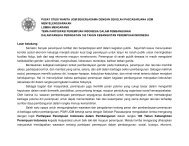Estimating the Codifference Function of Linear Time Series Models ...
Estimating the Codifference Function of Linear Time Series Models ...
Estimating the Codifference Function of Linear Time Series Models ...
You also want an ePaper? Increase the reach of your titles
YUMPU automatically turns print PDFs into web optimized ePapers that Google loves.
where (d k ) T = [d k 1 ,dk 2 , . . . ,dk r ], and <strong>the</strong> elements <strong>of</strong> dk i , i = 1, . . .r are<br />
d k i (1, 1) = (ReΦ(0, −s i; k)) −1<br />
d k i (2, 2) = (Re Φ(s i , 0; k)) −1<br />
d k i (3, 3) = (Re Φ(s i , −s i ; k)) −1 )<br />
and equal to 0, o<strong>the</strong>rwise. The asymptotic variance-covariance matrix is obtained from (28) as<br />
(( ) ( ))<br />
Re ˆτ<br />
lim N cov ∗ (s, −s; p) Re ˆτ<br />
N→∞ Im ˆτ ∗ ,<br />
∗ (s, −s; q)<br />
(s, −s; p) Im ˆτ ∗ = λL p<br />
(s, −s; q)<br />
2 V pqL q 2 λT (35)<br />
where<br />
V pq =<br />
( V<br />
RR<br />
pq<br />
V IR<br />
pq<br />
Vpq<br />
RI<br />
Vpq<br />
II<br />
) ( cov(ReZ<br />
p<br />
= lim N N , ReZq N ) cov(ReZp N , ImZq N ) )<br />
N→∞ cov(ImZ p N , ReZq N ) cov(ImZp N , ImZq N )<br />
(36)<br />
The matrix V pq can be obtained by applying Theorem 1 and Remark 2.6. in Hesse (1990). Its<br />
elements can be derived in a similar way as obtaining variance-covariance matrix in Theorem 1 <strong>of</strong><br />
Hesse (1990). This is possible, because it can be shown that all elements <strong>of</strong> V pq (in <strong>the</strong> form <strong>of</strong> sum<br />
<strong>of</strong> <strong>the</strong> absolute components) are finite. Therefore, one can apply <strong>the</strong> property <strong>of</strong> <strong>the</strong> sample mean<br />
<strong>of</strong> ergodic processes (e.g., Theorem 7.1.1. in Brockwell and Davis, 1987). Notice that here in particular,<br />
we obtain all elements <strong>of</strong> V pq with respect to cov(ReZ p N , ImZq N ) and cov(ImZp N , ReZq N )<br />
are zeros. The elements <strong>of</strong> V pq with respect to cov(ReZ p N , ReZq N ) and cov(ImZp N , ImZq N ) can<br />
be shown to be finite using identities (29)-(30) and applying a similar approach as obtaining eq.<br />
(21) and (23), and fur<strong>the</strong>r applying Theorem A.1, or sometimes, eq.(2.7) in Kokoszka and Taqqu<br />
(1994) toge<strong>the</strong>r with <strong>the</strong> similar steps as <strong>the</strong> pro<strong>of</strong> <strong>of</strong> Theorem A.1. However, we omit details.<br />
Proposition B.2 Let X t , t ∈ Z be <strong>the</strong> moving average process <strong>of</strong> order m, X t = ∑ m<br />
j=0 c jǫ t−j ,<br />
satisfying conditions C1 and C2. Then for h ∈ {1, 2, . . .}, s ∈ R, s ≠ 0<br />
[(<br />
Re ˆτ ∗ (s, 0)<br />
Im ˆτ ∗ (s, 0)<br />
) (<br />
Re ˆτ<br />
, . . . ,<br />
∗ (s, h)<br />
Im ˆτ ∗ (s, h)<br />
where M is <strong>the</strong> covariance matrix<br />
)]<br />
is AN<br />
([(<br />
τ(s, 0)<br />
0<br />
) (<br />
τ(s, h)<br />
, . . .,<br />
0<br />
)] )<br />
, N −1 M<br />
M = [ λL p 2 V pqL q 2 λT] p,q=0,...,h<br />
and <strong>the</strong> matrices λ,L k 2 , k = p, q and V pq are as given in Proposition B.1 above.<br />
Pro<strong>of</strong>.To show this relation, define vectors {Y t } by<br />
where<br />
where for j = 1, . . .,r<br />
Y T t = (Z t ,Z t+1 , . . . ,Z t+h )<br />
X k j = ⎛<br />
⎝<br />
⎛<br />
Z t+k = ⎜<br />
⎝<br />
X k 1<br />
X k 2<br />
.<br />
X k r<br />
⎞<br />
⎟<br />
⎠<br />
exp(−is j X t )<br />
exp(is j X t+k )<br />
exp(is j (X t+k − X t ))<br />
By definition, {Z t+k } is m+k-dependent sequence and <strong>the</strong>refore {Y t } is m+h-dependent sequence.<br />
Next define<br />
ζ T t = (ξ t , ξ t+1 , . . . , ξ t+h )<br />
⎞<br />
⎠<br />
13



